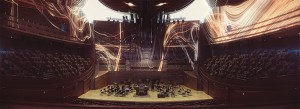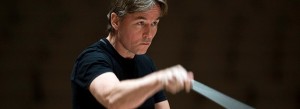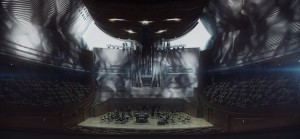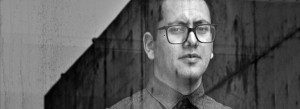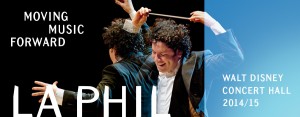THE LASERIUM OF THE 21ST CENTURY
While the result of the Los Angeles Philharmonic’s first in/SIGHT offering last weekend was mixed, the experimentation itself was a resounding success. Visual Artist Refik Anadol’s brand new multi-media fantasia accompanied Esa-Pekka Salonen’s vigorous and explosive rendition of Edgard Varèse’s Amériques, the final piece of an eclectic program titled Visions of America. Even at 25 repetitive, hit-and-miss minutes, the site-specific architectural video installation is in many ways revolutionary, and has opened the doors for a whole new classical music audience. This is the Laserium of the 21st century.
Instead of a Planetarium ceiling, the canvas here is Disney Hall’s upstage wall, which is made up of terraced seating and, dead center, the massive organ, appropriately nicknamed “French Fries” by its architect Frank Gehry (so massive is the orchestra that the upstage bench seats, normally used for either chorus or spectators, were removed). Since the upper walls of the east and west terrace are also utilized, the best seating appeared to be for those facing the stage.
The pounding “monster of a piece,” per Salonen’s opening comments, “is not pretty but impossible to ignore.” As promised, the ever-boyish Conductor Laureate made the work, written between 1918 and 1921 and revised in 1927, shockingly alive. Varèse melds the impressionism of Stravinsky and Debussy with the awesome commotion of New York (including police sirens) and the limitless possibilities afforded by the same New World that inspired Dvorak’s Ninth Symphony. It may begin with morsels of birdsong, but that is just a wind-up of an Industrial Revolution motor; a rhythmic, almost frightening, modernity that blitzes the listener with (seemingly) disordered bombardments of percussion and unconventional orchestral effects that lead to a brash and very loud pandemonium.
The mostly black-and-white visuals also vacillated between impressionistic and literal—some more effectively than others. Images included snow, red fireworks, moving shadows, swirling geometric patterns, flying origami, astronomical flare-ups, waving flora, neural networks, ghostly alien figures, and a warping geosphere. At the halfway point, the fascinating computer imagery became tedious, and some of the literal work—the New York cityscape for example—was too distorted when competing with the pipes of that vast organ (especially from my east terrace vantage point). Most successful were the parquet images on the flat wood sections.
While I was excited to hear and see that glorious score pop to life—and equally thrilled to be at the birth of something unique—it was a long mind-stretch (that can happen at Laserium shows, too, which may explain their attraction to stoners).
Here is a “teaser” of the Amériques:
https://www.youtube.com/watch?v=9PjriuGtMec
Salonen stated that this type of computer art may one day make sets obsolete. He may be right, but the art must match the work, just as the fiber optic backdrop in Chicago Shakespeare’s Sunday in the Park with George illuminated Seurat’s world. In Act II of Sunday, Seurat’s great-grandson allows technology to get in the way of his art. Similarly, it doesn’t serve the finished product that Salonen’s body movements were “captured by next generation Microsoft Kinect hardware and 3-D depth camera analysis to inform the visuals displayed.” And although Anadol used “custom-built algorithmic sound analysis to listen and respond to the music in real time,” the display was sometimes dismayingly out of synch with the music.
It’s a good thing that Anadol’s commissioned video for Berlioz’ Romeo & Juliet was postponed due to technical difficulties. For all my quibbles, Amériques definitely whet my appetite for more, and the shorter piece allows for a working curve that the over-100-minute Berlioz could not have afforded.
Even with Salonen’s explications about Central-European tradition morphing into uniquely American sounds, this program definitely consisted of “very strange bedfellows.” The opening half began with Bernard Herrmann’s music from Psycho. The subtitle of “suite” was hardly appropriate—this was more like tiny chopped up pieces from the iconic film score (11 selections running about 18 minutes with pauses). Still, the strident strumming, shrieking glissandi, and slapping and plucking were perfectly executed by the all-string orchestra. Sharp as a knife, you could say.
At first, I wasn’t sure if mezzo-soprano Susan Graham was going to tackle the song selections by Kurt Weill, as she didn’t vocally trade coloratura for chanteuse. However, her tongue-in-cheek performance—complete with martini glass—won me over because she acted each song resplendently. Even when a song was short in length (“Das Lied von der Harten Nuts”) she was long in character, even offering some bluesy growling in “I Am a Stanger Here Myself.” And with her warm lower register and supple high register, the ballads were flawlessly sumptuous (“My Ship,” “September Song”). If only she didn’t need to espy lyrics from that songbook sitting on her cocktail table.
Salonen’s own Foreign Bodies (2000) was no doubt chosen for other than Europeans-in-America reasoning: It calls for a large orchestra. Salonen’s showpiece showcases the versatility of instruments—percussion is used melodically and strings are played percussively—and he utilizes many exotic instruments. The result is a big sound musically, coming across like a Finnish/Spanish fantasy on a Dialogue of the Wind and the Sea. It certainly offered principals a chance to shine, and Salonen’s use of rhythm rather than melody to inform the piece’s construction made the work captivating and commanding at first. However, it is so unspecific in emotion and ideas that even at 20 minutes, my mind wandered all over the place. Salonen is a master conductor—one of our best really—but his work was bemusing, and received a tepid response from the audience. Perhaps if Foreign Bodies had the same fascinating light show as Amériques, it would have received the same warm and supportive ovation afforded to Varèse and Anadol (who was in attendance).
Remaining in/SIGHT concerts in the 2014/15 season are: the staged production of Beethoven’s Missa Solemnis with video, conducted by Michael Tilson Thomas (January 9 – 11, 2015); the West Coast premiere of Unsuk Chin’s fully-staged opera Alice in Wonderland, featuring unique use of video projection created by director/designer Netia Jones combined with the gonzo illustrations of Fear and Loathing in Las Vegas artist Ralph Steadman (February 27 – 28, 2015); and Steve Reich’s Three Tales performed by Ensemble Signal, led by their music director Brad Lubman and accompanied by images from video artist Beryl Korot (May 29, 2015).
photos courtesy of LA Phil
Los Angeles Philharmonic
Esa-Pekka Salonen, conductor
Refik Anadol, visual artist
Susan Graham, mezzo-soprano
Walt Disney Concert Hall, 111 S. Grand Ave.
played November 6-9, 2014
for future events, call 323.850.2000 or visit www.LAPhil.com
see the complete in/SIGHT calendar here

